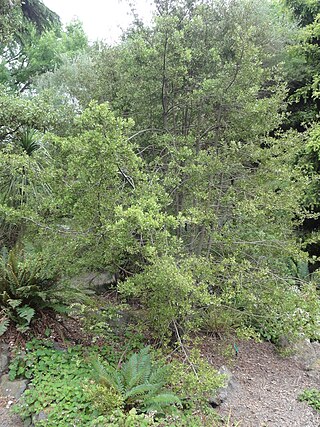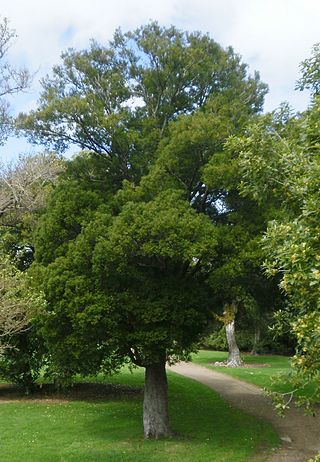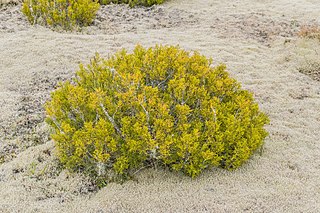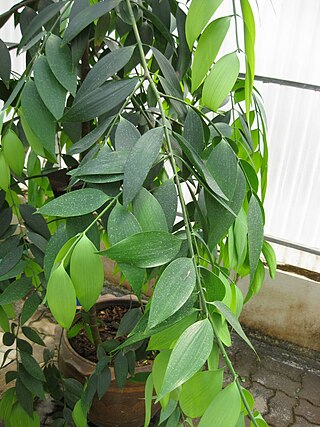
Podocarpus latifolius is a large evergreen tree up to 35 m high and 3 m trunk diameter, in the conifer family Podocarpaceae; it is the type species of the genus Podocarpus.

Dacrydium cupressinum, commonly known as rimu, is a large evergreen coniferous tree endemic to the forests of New Zealand. It is a member of the southern conifer group, the podocarps.

Podocarpus totara is a species of podocarp tree endemic to New Zealand. It grows throughout the North Island and northeastern South Island in lowland, montane and lower subalpine forest at elevations of up to 600 m.

Prumnopitys taxifolia, the mataī or black pine, is an endemic New Zealand coniferous tree that grows on the North Island and South Island. It also occurs on Stewart Island/Rakiura but is uncommon there.

Phyllocladus, the celery pines, is a small genus of conifers, now usually placed in the family Podocarpaceae.Species occur mainly in New Zealand, Tasmania, and Malesia in the Southern Hemisphere, though P. hypophyllus ranges into the Philippines, a short way north of the equator.

Platycladus is a monotypic genus of evergreen coniferous trees in the cypress family Cupressaceae, containing only one species, Platycladus orientalis, also known as Chinese thuja, Oriental arborvitae, Chinese arborvitae, biota or Oriental thuja. It is native to northeastern parts of East Asia and North Asia, but is also now naturalised as an introduced species in other regions of the Asian continent.

Podocarpus is a genus of conifers, the most numerous and widely distributed of the podocarp family, the Podocarpaceae. The name comes from Greek πούς + καρπός. Podocarpus species are evergreen shrubs or trees, usually from 1 to 25 m tall, known to reach 40 m (130 ft) at times. The cones have two to five fused cone scales, which form a fleshy, berry-like, brightly coloured receptacle at maturity. The fleshy cones attract birds, which then eat the cones and disperse the seeds in their droppings. About 97 to 107 species are placed in the genus depending on the circumscription of the species.

Nageia is a genus of conifers belonging to the podocarp family Podocarpaceae. Nageia includes evergreen shrubs and trees, from one to 54 meters in height. A 2009 treatment of the genus recognized five species. Some authors consider Nageia formosensis to be a separate species from Nageia nagi, thus recognizing six species. The podocarp genera have been reshuffled by various botanists. Most recently, several species formerly classed as Nageia were moved to the new genus Retrophyllum, while Nageia falcata and Nageia mannii were moved to the new genus Afrocarpus.

Prumnopitys is a genus of conifers belonging to the family Podocarpaceae. The nine recognized species of Prumnopitys are densely branched, dioecious evergreen trees up to 40 metres in height.

Podocarpus macrophyllus is a conifer in the genus Podocarpus, family Podocarpaceae. It is the northernmost species of the genus, native to southern Japan and southern and eastern China. Common names in English include yew plum pine, Buddhist pine, fern pine and Japanese yew. Kusamaki (クサマキ) and inumaki (犬槇) are Japanese names for this tree. In China, it is known as luóhàn sōng (羅漢松), which literally means "arhat pine".

Aristotelia serrata, commonly known as wineberry or in the Māori language makomako or just mako, is a small tree in the family Elaeocarpaceae, in the genus Aristotelia, found in the North Island, South Island and Stewart Island of New Zealand. It is a small deciduous fast-growing tree or shrub. The tree can reach up to 10m tall, with a trunk diameter up to 30 cm. The bark is pale brown, smooth and patterned with flat lenticels. Branches are long, slender and spreading, branchlets have a reddish-brown colour when pubescent.

Prumnopitys andina, the lleuque or Chilean plum yew, is an evergreen coniferous tree native to south-central Chile and a few areas in adjacent parts of westernmost Argentina from 36 to 40° South latitude. It lives on moderately wet soils, preferably on Andean slopes from 500–1,100 meters (1,600–3,600 ft).

Halocarpus bidwillii, commonly known as the mountain pine or bog pine, is a species of conifer in the family Podocarpaceae. It is endemic to New Zealand.

Juniperus deppeana is a small to medium-sized tree reaching 10–15 metres in height. It is native to central and northern Mexico and the southwestern United States.

Podocarpus elatus, known as the plum pine, the brown pine, the Illawarra plum or the Queensland Christmas tree, is a species of Podocarpus endemic to the east coast of Australia, in eastern New South Wales and eastern Queensland.

Juniperus monosperma is a species of juniper native to western North America, in the United States in Arizona, New Mexico, southern Colorado, western Oklahoma (Panhandle), and western Texas, and in Mexico in the extreme north of Chihuahua. It grows at 970–2300 m altitude.

Libocedrus bidwillii, also called pāhautea, kaikawaka or New Zealand cedar, is a species of Libocedrus, endemic to New Zealand. It is in the cypress family Cupressaceae.

Libocedrus plumosa, with the common name kawaka, is a species of Libocedrus that is endemic to New Zealand.

Nageia wallichiana is a species of conifer in the family Podocarpaceae. It is a tree 10–54 m high, found in Brunei, Cambodia, China, India, Indonesia, Laos, Malaysia, Myanmar, Thailand, and Vietnam. Nageia wallichiana is the most widely distributed species among the seven species in the genus Nageia. If the land areas of China and Japan are excluded, its distribution nearly coincides with that of the genus and includes both the western outliers in India and the easternmost part on Normanby Island. It is one of the most extensive conifer ranges recognized and is similar to Dacrycarpus imbricatus and Podocarpus neriifolius.

Euclea crispa, commonly known as the blue guarri, is an Afrotropical plant species of the family Ebenaceae. The hardy and evergreen plants may form a dense stand of shrubs, or grow to tree size. It is widespread and common in the interior regions of southern Africa, and occurs northward to the tropics. Though some are present near the South African south and east coasts, they generally occur at middle to high altitudes. It is readily recognizable from its much-branched structure and dull bluish foliage colour. Those bearing lanceolate leaves may however resemble the Wild olive, another common species of the interior plateaus.






















